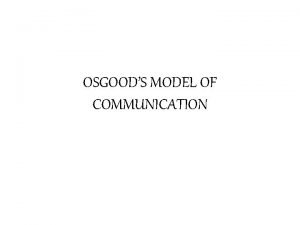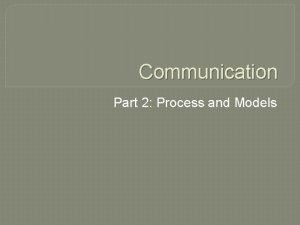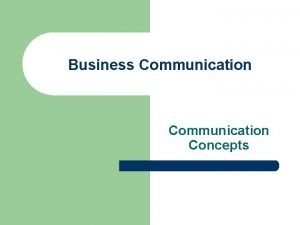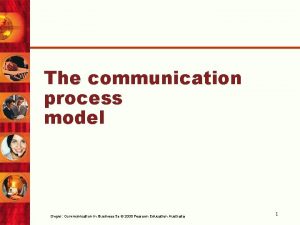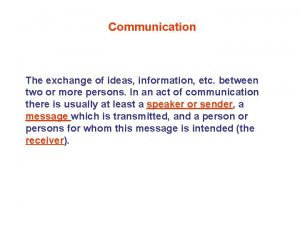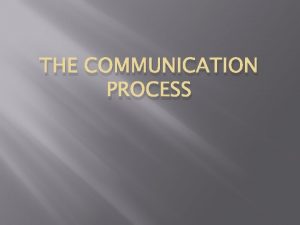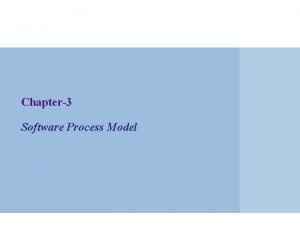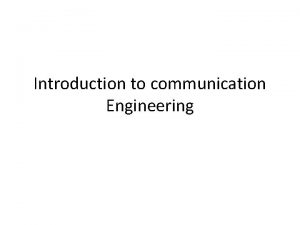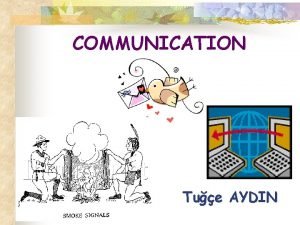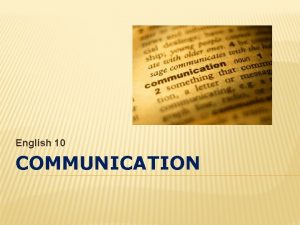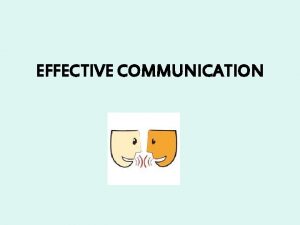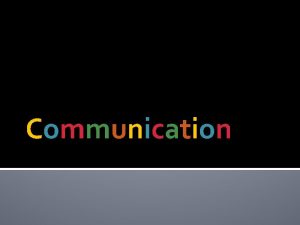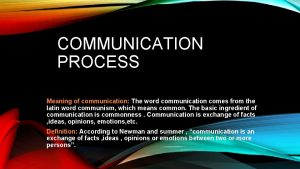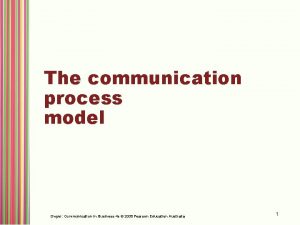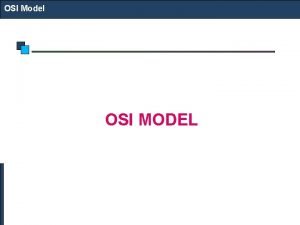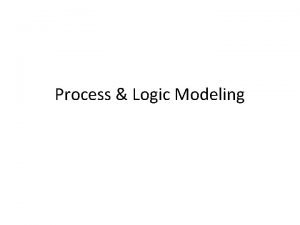A Model Of The Communication Process 1 Introduction







































- Slides: 39

A Model Of The Communication Process 1

Introduction • We define communication operationally – with a model showing how it works. • The model describes face–to–face communication. Later we adapt it to writing. • The model relies heavily on theory. 2

A common misconception. • Communication is not a natural human activity. • Human communication, at least the verbal part of it – is far from being a natural function, that is, it is not the sort of thing we would do if left to nature’s devices , as we would many of our other activities. 3

A common misconception (Cont. ) • We learn to communicate. • It is not instinctive but taught. • It was originated by human beings and it must be acquired from human beings 4

The Communication Environment • Communication occurs in a sensory environment – the real world with all the signs the senses can detect. • It is made up of all the signs existing in the world of reality that surrounds each of us. • Your sensory environment is the real world surrounding you as you read these words. 5

The Communication Environment (Cont. ) • By Real World we mean that which actually exists. • It contrasts with the world that exists only in peoples minds. • Of course one may argue that what exists in the mind also is real – that, right or wrong, the content of a mind exists only in that mind. 6

The Communication Environment (Cont. ) • By Signs we mean everything from the real world that can act as a stimulus to us. • In other words, it is everything that our sensory receptors can detect. • They produces responses in us. 7

The Communication Environment (Cont. ) • By Sensory Receptors we mean those body organs that we use to detect the signs in the real world. • Specially the term refers to our eyes, noses, ears, mouths and flesh with its ability to detect surface and temperature differences. 8

The Communication Environment (Cont. ) • Sign Detections: – Our sensory receptors continuously pick up some of the infinite number of signs existing in our communication environment. – Stated another way, the signs around us continuously produce responses within us through our receptors. 9

The Communication Environment (Cont. ) • Consider these words that you are reading. Do you notice other signs? • Perhaps you are not picking up all of them • Perhaps there are noises around you • From time to time you may become aware of being hot or cold, or your back may itch, or your sitting positions may become uncomfortable. 10

The Communication Environment (Cont. ) • Thus, as have read the previous slide, your sensory receptors have continuously picked up signs from all these parts of the reality that surrounds you. 11

The Communication Environment (Cont. ) • Sensory Limitations: – Sensory Receptors are limited; they detect only a small part of the real world. – In short they are restricted – They are not capable of detecting all the signs that we know exists in the real world. 12

The Communication Environment (Cont. ) • Sensory Limitations (Cont. ): Examples: – Our eyes can detect only a small part of the total spectrum of wavelengths, and ability to detect from these wavelengths vary from person to persons. – Dogs and birds can hear much that we cannot – We can smell only the strong odor, while dogs do a much better job of smelling. 13

The Communication Environment (Cont. ) • Selective perception: – Sensory receptors select signs to detect. – They tune in on one and ignore others. – Example: • Place yourself in a roomful of talking people, and notice how you are able to tune in on one conversation and ignore others. • Or notice how you are able to focus to your vision on one minute object and then expand your view to a much broader picture. 14

The Communication Environment (Cont. ) • Varying alertness and perception: – Our detection or nondetection of signs also depends on our receptiveness to sign. – Our perception varies with the our degree of mental alertness. – When you are asleep, you detect almost none. 15

The Communication Process • With the communication environment as a base, we shall review the communication process. 16

The Communication Process (Cont. ) Feedback Sender Thought Encoding Receiver Message transmission Reception Understand Decoding Noise 17

The Communication Process (Cont. ) Encoding • The sender generates thoughts to be conveyed. • The sender encodes the thoughts with both verbal and non-verbal cues (Gestures). • Noises from outside may disturb the encoding, which may alter the meaning. 18

The Communication Process (Cont. ) Transmission: • The encoded message gets transmitted to the receiver. During the transmission, the both external and internal noise may alter the intended meaning of the original message. 19

The Communication Process (Cont. ) • Receiving and Decoding ØThe receiver accepts the messages. Ø(S)He then assigns meaning to the message according to his mental filter. ØWith the meaning assigned, the receiver understands the messages and sends feedback to the sender. 20

The Communication Process (Cont. ) • Sending feedback also applies the same cycle. • And the cycle keeps moving. 21

The Communication Process (Cont. ) • Reception of signals: – The signs echo and re-echo throughout the receiver’s nervous system – This is the preverbal neurophysiological stage 22

The Communication Process (Cont. ) • Flow to the brain: – Eventually the stimuli from the signs reach the receivers brain. – The sensory flow is continuous but may vary with sign intensity and degree of mental alterness. 23

The Communication Process (Cont. ) • Role of the filter – The mind filters the stimuli and gives meaning to them – The filter includes knowledge, viewpoints and emotions that influence interpretation of signs 24

The Communication Process (Cont. ) • Role of the filter (Cont. ): – All filters are unique because no two people have identical experiences, thoughts and emotional makeups. – Thus meanings given to signs differ. – Meaning depends on filter content. – Words are but one type of sign 25

The Communication Process (Cont. ) • Role of the filter (Cont. ): – Seeing snakes, feeling cool breezes and such are non verbal signs we could detect. – Many signs produce multiple, mixed or confused meanings. – For example, we could respond to a politician numerous ways. 26

The Communication Process (Cont. ) • Role of the filter (Cont. ): – Meanings in the filter may trigger reactions – physical, verbal or both, most reactions are verbal. 27

The Communication Process (Cont. ) • The symbolizing stage: – The symbolizing stage begins when the mind searches for symbols (usually) words with which to express the intended meaning. – Intellect and knowledge of language relate directly to competency in symbolizing – Symbolizing imperfect because of language and human limitations. 28

The Communication Process (Cont. ) • Act Of Encoding: – Encoding concludes the first cycle of the communication process. – It involves sending word and nonverbal symbols to a receiver. 29

The Cycle Repeated • The first receiver now becomes sender and vice versa. • Then Identical communication cycle begins. • Communication occurs if receiver get the meaning sender intended. • The meaning receiver receive may cause him to respond, then another cycle occurs and the process may go on and on. 30

The model and written communication • Three differences exist when we apply the model to writing. 1. Greater Creativity 2. Time Lag 3. Limited Number of Cycle 31

The model and written communication (Cont. ) • Greater Creativity: – Written communication involves more creative efforts of the mind – In report writing, for example, there is little message exchange. The final words are carefully though out. – Letter writing may involve some exchanges, but even the messages are deliberate and creative. 32

The model and written communication (Cont. ) • Time Lag: – Time delays occur in moving written messages to others’ sensory environments. – Feedback is slow. • Limited Number of Cycles: – Written communication has fewer cycles. – Most writing involves only one cycle. 33

Universal Ingredients of Human Communication • Human communication ahs four universal ingredients: – – The communication environment, The Mental Filter, The encoding, and decoding process. 34

Some fundamental truths of communication 1. Communication is imperfect: – Communication is imperfect – Symbols are imprecise, and – peoples’ encoding skills vary. 35

Some fundamental truths of communication (Cont. ) 2. We communicate about ourselves: – – – We project ourselves into our communications The symbols we select for a message tells how we feel. We communicate based on only a small part of reality 36

Some fundamental truths of communication (Cont. ) 3. Meaning is in the mind: • • • People have meanings but symbols do not Communication is successful when two people give similar meanings to symbols. Emphasize the intended meaning in the sender’s mind – not the meaning received in your mind. 37

Questions a. Explain the model of communication with a clear diagram. b. What are common misconceptions about communication? c. What are universal ingredients of communication? d. What is the difference between written and oral communication model? 38

Thank You 39
 Process communication model
Process communication model Osgood schramm model of communication
Osgood schramm model of communication Communication process model
Communication process model The communication process model
The communication process model Communication process model
Communication process model Roman jakobson communication model
Roman jakobson communication model Hát kết hợp bộ gõ cơ thể
Hát kết hợp bộ gõ cơ thể Frameset trong html5
Frameset trong html5 Bổ thể
Bổ thể Tỉ lệ cơ thể trẻ em
Tỉ lệ cơ thể trẻ em Voi kéo gỗ như thế nào
Voi kéo gỗ như thế nào Tư thế worm breton
Tư thế worm breton Alleluia hat len nguoi oi
Alleluia hat len nguoi oi Môn thể thao bắt đầu bằng chữ đua
Môn thể thao bắt đầu bằng chữ đua Thế nào là hệ số cao nhất
Thế nào là hệ số cao nhất Các châu lục và đại dương trên thế giới
Các châu lục và đại dương trên thế giới Công thức tính độ biến thiên đông lượng
Công thức tính độ biến thiên đông lượng Trời xanh đây là của chúng ta thể thơ
Trời xanh đây là của chúng ta thể thơ Mật thư anh em như thể tay chân
Mật thư anh em như thể tay chân Làm thế nào để 102-1=99
Làm thế nào để 102-1=99 độ dài liên kết
độ dài liên kết Các châu lục và đại dương trên thế giới
Các châu lục và đại dương trên thế giới Thơ thất ngôn tứ tuyệt đường luật
Thơ thất ngôn tứ tuyệt đường luật Quá trình desamine hóa có thể tạo ra
Quá trình desamine hóa có thể tạo ra Một số thể thơ truyền thống
Một số thể thơ truyền thống Cái miệng nó xinh thế
Cái miệng nó xinh thế Vẽ hình chiếu vuông góc của vật thể sau
Vẽ hình chiếu vuông góc của vật thể sau Nguyên nhân của sự mỏi cơ sinh 8
Nguyên nhân của sự mỏi cơ sinh 8 đặc điểm cơ thể của người tối cổ
đặc điểm cơ thể của người tối cổ Thế nào là giọng cùng tên?
Thế nào là giọng cùng tên? Vẽ hình chiếu đứng bằng cạnh của vật thể
Vẽ hình chiếu đứng bằng cạnh của vật thể Fecboak
Fecboak Thẻ vin
Thẻ vin đại từ thay thế
đại từ thay thế điện thế nghỉ
điện thế nghỉ Tư thế ngồi viết
Tư thế ngồi viết Diễn thế sinh thái là
Diễn thế sinh thái là Các loại đột biến cấu trúc nhiễm sắc thể
Các loại đột biến cấu trúc nhiễm sắc thể Thế nào là số nguyên tố
Thế nào là số nguyên tố Tư thế ngồi viết
Tư thế ngồi viết

